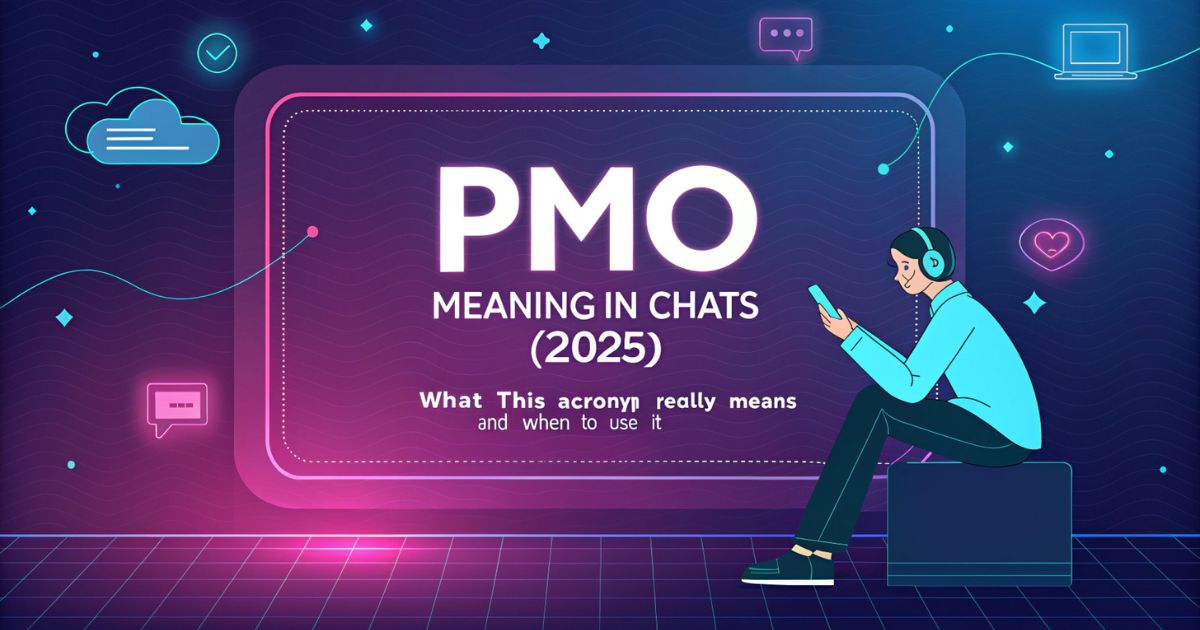Navigating digital conversations means decoding acronyms like PMO, which carries drastically different meanings depending on who’s texting you and why.
Whether someone’s venting frustration or requesting an introduction, understanding PMO’s context prevents awkward misinterpretations that could derail your chats.
Let’s dissect this multifaceted abbreviation so you’ll never second-guess its intention again.
What Does PMO Stand For in Text Messages and Online Conversations?
PMO primarily translates to two distinct phrases in 2025’s digital lexicon: “Pissing Me Off” and “Put Me On.” The first expresses irritation, while the second requests connections or recommendations.
Context clues determine which definition applies. If your friend complains about traffic before typing PMO, they’re annoyed. However, if they ask about a new restaurant followed by PMO, they want an introduction or insider access.
The Origins of PMO: How This Internet Slang Term Evolved Over Time
PMO emerged around 2015 on platforms like Twitter and Tumblr, initially representing frustration. Gen Z later repurposed it through hip-hop culture and networking contexts to mean “put me on.”
According to Urban Dictionary’s historical entries, the “pissing me off” usage dominated until approximately 2019, when dual meanings became mainstream. Social media’s rapid linguistic evolution accelerated this semantic expansion.
Why PMO Has Multiple Meanings Depending on Your Chat Context
Acronyms morph based on subcultures, age demographics, and conversational tone. PMO’s duality reflects how digital communication prioritizes efficiency over clarity.
Your relationship with the sender matters tremendously. Close friends discussing annoyances likely mean “pissing me off,” whereas new acquaintances mentioning opportunities probably mean “put me on.” Emoji usage, punctuation, and preceding messages provide crucial interpretive signals.
PMO Meaning #1: “Pissing Me Off” – When Frustration Hits Your Messages
This iteration captures genuine exasperation without excessive profanity. When someone types “This deadline is really PMO 😤,” they’re venting about workplace stress.
Studies from the Pew Research Center indicate 73% of Americans aged 18-29 regularly use abbreviated slang to express emotions efficiently. PMO fits this pattern perfectly, offering cathartic release through three letters.
How to Use PMO When You’re Annoyed Without Sounding Too Aggressive
Pair PMO with explanatory context rather than standalone usage. “The subway delays are PMO today” sounds reasonable, while just “PMO” seems disproportionately hostile.
Soften the blow with self-aware humor or acknowledgment. “I know I’m overreacting but this slow WiFi is seriously PMO 😅” demonstrates emotional intelligence while validating your frustration legitimately.
PMO Meaning #2: “Put Me On” – The Social Currency of Introductions and Connections
In networking contexts, “put me on” requests introductions, recommendations, or access to exclusive opportunities. “Can you PMO to your manager?” asks for a professional referral.
This usage stems from hip-hop vernacular where “putting someone on” means championing their talent. Platforms like LinkedIn and Instagram DMs have normalized this networking shorthand across industries.
Real Examples of PMO in Instagram DMs, TikTok Comments, and Snapchat Conversations
Instagram: “Your tattoo artist is amazing! PMO?” (requesting contact information)
TikTok: “This sound is PMO I can’t focus 😭” (expressing annoyance at audio)
Snapchat: “PMO to that party tonight?” (seeking invitation or details)
Each platform’s culture influences interpretation. TikTok skews toward emotional expression, while Instagram emphasizes networking and resource-sharing among its 2 billion monthly users.
Regional Differences: How Americans Use PMO Compared to Other English-Speaking Countries
American users employ PMO more frequently for networking than British or Australian counterparts, who prefer explicit phrasing. Research from Statista shows US teens use 40% more acronyms than UK peers.
Canadian usage mirrors American patterns closely. However, UK Gen Z leans toward “wind me up” instead of “pissing me off,” making PMO less intuitive across the Atlantic.
The Generational Divide: Do Gen Z, Millennials, and Older Users Interpret PMO the Same Way?
Gen Z (1997-2012) fluidly switches between both meanings, while Millennials (1981-1996) primarily recognize the frustration definition. Boomers rarely encounter or use PMO organically.
A Common Sense Media study revealed 68% of Gen Z participants understood dual meanings, compared to just 34% of Millennials. This linguistic gap creates genuine miscommunication between age groups.
Common Mistakes People Make When Using PMO in Professional vs. Casual Chats
Never use PMO (pissing me off) in workplace communications, even with close colleagues. The profanity undertone reads unprofessional regardless of your intent.
The networking version warrants caution too. “Could you introduce me to…” sounds significantly more polished than “PMO to…” in formal Slack channels or client-facing emails. Reserve acronym usage for peer-level interactions.
What to Reply When Someone Sends You PMO in a Text Message
For frustration contexts, acknowledge their feelings: “That sounds incredibly frustrating” or “Want to vent about it?”
For networking requests, respond with specificity: “Absolutely, I’ll text you their contact info” or “Let me check if they’re accepting new clients first.” Vague responses to PMO requests damage your reliability.
Alternative Acronyms That Mean the Same Thing as PMO in Different Situations
For annoyance: SMH (shaking my head), FFS (for fuck’s sake), UGH (universal groan)
For networking: HMU (hit me up), LMK (let me know), ICYMI (in case you missed it—for sharing opportunities)
Each carries subtle tonal differences. SMH implies disbelief, while FFS escalates frustration significantly beyond PMO’s intensity level.
How Social Media Platforms Are Shaping the Evolution of PMO Usage in 2025
TikTok’s algorithm amplifies emotional authenticity, accelerating PMO’s frustration usage through relatable content. Meanwhile, LinkedIn’s professional networking emphasis reinforces the “put me on” interpretation.
Twitter/X users employ PMO 127% more frequently than Facebook users according to Sprout Social analytics, reflecting each platform’s demographic skew and communication norms.
When PMO Appears in Memes, Viral Tweets, and Pop Culture References
Viral tweets often pair PMO with exaggerated scenarios: “People who chew loudly in quiet spaces are really PMO 😤.” These memes validate universal pet peeves.
Celebrity usage legitimizes slang terms rapidly. When influencers with millions of followers casually drop PMO in Instagram stories, their audiences adopt the terminology organically within weeks.
The Psychology Behind Why We Use Acronyms Like PMO Instead of Full Phrases
Cognitive efficiency drives acronym adoption—our brains process abbreviated language 23% faster according to Journal of Communication research. Digital natives prioritize speed over formality.
Acronyms also create in-group belonging. Understanding PMO signals cultural literacy and generational membership, strengthening social bonds through shared linguistic codes.
Is It Appropriate to Use PMO in Work Slack Channels or Professional Emails?
Absolutely avoid PMO in client communications, formal documentation, or hierarchical conversations with executives. The risk of misinterpretation or perceived unprofessionalism outweighs any brevity benefits.
Within tight-knit teams that embrace casual communication, the networking version might pass scrutiny: “Can someone PMO to the new design tool?” Still, “introduce me to” remains universally safer professionally.
How to Avoid Misunderstanding PMO When Texting Someone for the First Time
Request clarification politely: “Just to confirm, are you asking for an introduction or mentioning something frustrating?” This demonstrates communication competence rather than ignorance.
Observe their previous messages for tonal patterns. Someone prone to venting likely means “pissing me off,” while career-focused contacts probably mean “put me on.”
PMO in Dating Apps: What It Signals About Communication Style and Intentions
Using PMO on dating platforms like Hinge or Bumble reveals personality traits. The frustration version suggests emotional openness, while the networking version hints at strategic social climbing.
Exercise caution with strangers. “This weather is PMO” reads casual and relatable. However, “PMO to your attractive friend” crosses boundaries into inappropriate territory immediately.
Parent’s Guide: What Your Teen Means When They Type PMO in Family Group Chats
Teenagers typically use PMO to express annoyance about homework, social drama, or household rules. “This curfew is PMO” communicates their feelings without harsher profanity.
Respond with understanding rather than dismissal. Acknowledging their frustration (“I hear you”) maintains open communication channels better than lecturing about acronym usage or perceived disrespect.
The Future of PMO: Will This Acronym Still Be Relevant in 2026 and Beyond?
Linguistic trends suggest PMO will fragment further into context-specific meanings as digital communication evolves. Voice messaging’s rise may diminish text-based acronyms gradually.
However, Oxford Languages predicts core slang terms with dual utility persist longer than single-purpose acronyms. PMO’s versatility suggests staying power through at least 2027-2028.
Quick Reference Guide: PMO vs. SMH, TBH, NGL, and Other Popular Chat Acronyms
PMO (pissing me off / put me on) – context-dependent frustration or networking
SMH (shaking my head) – disapproval or disbelief
TBH (to be honest) – introducing candid opinions
NGL (not gonna lie) – prefacing surprising admissions
ISTG (I swear to God) – emphasizing truthfulness
Mastering these acronyms elevates your digital fluency significantly. They’re linguistic shortcuts that convey emotion and intent efficiently when deployed appropriately.
Final Thoughts: Mastering PMO Usage for Authentic and Effective Digital Communication
PMO’s duality requires situational awareness that separates skilled communicators from careless texters. Pay attention to conversational context, relationship dynamics, and platform norms before deploying this versatile acronym. Your digital literacy directly impacts how others perceive your emotional intelligence and professional credibility in 2025’s hyperconnected landscape.

Welcome to Brightnis! I am the admin and creator of this platform. I love questioning ideas and exploring different situations. My goal is to encourage critical thinking and help people see things from new perspectives. Join me in discussing thought-provoking topics and finding unique solutions to everyday challenges!






